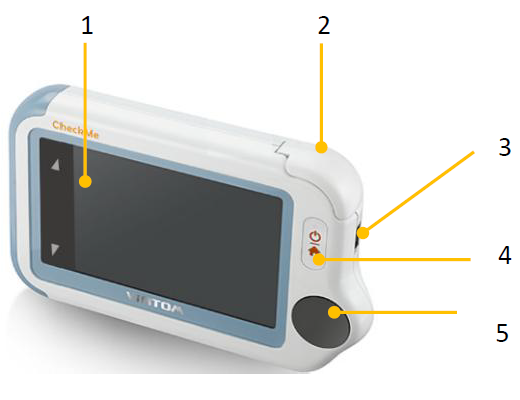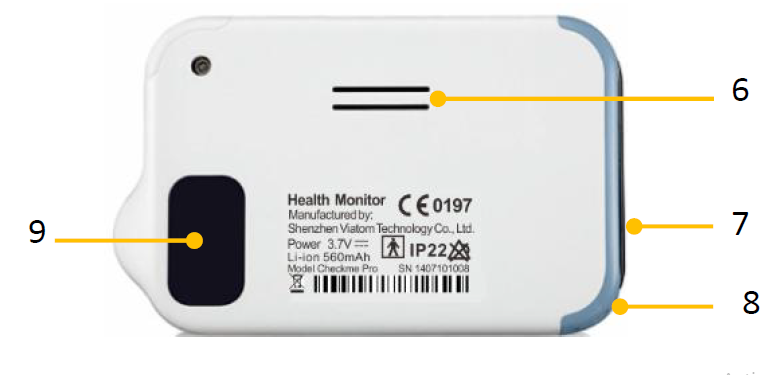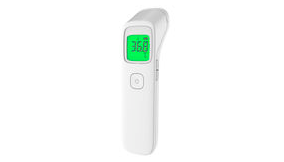Viatom Checkme Lite Health Monitor User Manual

About Checkme
Intended Use
The Checkme Lite health monitor is intended to be used for measuring, displaying, storing and reviewing of multiple physiological parameters including ECG, pulse oxygen saturation (SpO2) and systolic blood pressure (SBP) in home or healthcare facilities environment.
Outline
ECG and SBP are intended for use with adult.The data and results provided by this device are for pre -check screening purpose only and cannot be directly used for diagnostic or treatment.

- Touch Screen
- Internal SpO2 sensor
- Micro-USB connector It connects with USB cable for charging.
- Home button
- When the monitor is off, press this button to power it on.
- When the monitor is on, press and hold it for 2 seconds to turn it off.
- During operation, press this button will switch to Main Screen or return to upper menu.
- ECG right electrode (Put right thumb on it.)
 Speaker
Speaker- ECG left electrode (Put it to your left palm, left abdomen or left knee.)
- Neck stripe hole
- ECG back electrode
Main Screen
The Main Screen is shown as below.

Press an icon in the Main Screen will start a measurement, activate a function, or open corresponding menu. The device will enter Main Screen when:
- No operation is detected for 60 seconds in result screen, the device will automatically switch to Main Screen.
- Pressing the Home button in other screen interface. You can change the sound volume by taping the button on the left of the screen, then tap the <Volume> area. Or you can also go to the Setting menu to change it.
Symbols
| Symbol | Meaning |
 | Application part type BF |
 | Manufacturer |
| CE0197 | In conformity with Directive 93/42/EEC |
 | European Representative |
 | Symbol for “ENVIRONMENT PROTECTION – Waste electrical products should not be disposed of with household waste. Please recycle where facilities exist. Check with your local authority or retailer for recycling advice”. |
| IP22 | Against ingress of solid foreign objects ≥12.5mm diameter; Against dripping (15° tilted) |
 | Follow operating instructions |
Getting Started
Power On/Off
Press the Home button to power on the device. Press and hold Home button for 2 seconds to power off the device.
Initial Settings
The first time when the Check me is powered on, you can set up your Check me step by step. You can also change the settings in the <Settings> menu.
Using Check me
Prior to Use Before using ECG
- If your skin or hands are dry, moisten them before taking the measurement.
- During the measurement, do not touch your body with the hand with which you are taking the measurement.
- Please note that there must be no skin contact between your right and left hand.Otherwise, the measurement cannot be taken correctly.
- Stay still during the measurement, do not speak and move.
- If possible, take the measurement when sitting instead of standing.
Before using Oximeter
Before using Daily Check and Oximeter function, pay attention to the following points in order to obtain precise measurements.
- The finger inserted in SpO2 sensor must be clean.
- Any of the following conditions may cause inaccurate measurements, including but not limited to:
- Flickering or very bright light;
- Poor blood circulation;
- Low hemoglobin;
- Hypotension, severe vasoconstriction, severe anemia or hypothermia;
- Nail polish, artificial nails;
- Any tests recently performed on you that required an injection of intravascular dyes.
- The Oximeter may not work if you have poor circulation. Rub your finger to increase circulation, or place the SpO2 sensor on another finger.
- The Oximeter measures oxygen saturation of functional hemoglobin.High levels of dysfunctional hemoglobin (caused by sickle cell anemia, carbon monoxide, etc.) could affect the accuracy of the measurements.
- The pleth waveform displayed on the device is normalized.
Warnings and Cautionary Advices
- Limit finger movement as much as possible when using the Daily Check or Oximeter, which might result in incorrect reading or analysis.
Maintenance
Battery
This monitor is designed to operate on rechargeable Lithium-ion battery.The battery is charged automatically when the monitor is connected to a powered USB port.On-screen battery symbols indicate the battery status as follow:
The battery is fully charged.The solid portion represents the remained battery energy. If the solid portion moves from left to right, then it means that the battery is being charged.Indicates that the battery is almost depleted and need to be charged immediately.

Otherwise the device will shut down automatically. To charge the battery, connect the USB charging cable as shown The device cannot be used for any measurement during charging. Use USB charging devices comply with electrical safety standard, for example IEC 60950.
Care and Cleaning
Clean the device by carefully swabbing the device surface with a soft cloth swab with water or alcohol.
Trouble Shooting
| Problem | Possible Cause | Solution |
| The device does | 1. The battery may be | 1. Charge the battery |
| not turn on. | low. 2. The device might be damaged | and try again. 2. Please contact with your local distributor. |
| The ECG waveform | The lead you choose is not suitable for you. | Change another lead and try again. |
| amplitude is small | ||
| ECG waveform | 1. The pressure exerted | 1. Hold the device |
| drifts | on the electrode is not stable or too much. 2. Hand or body may be moving. | stably and gently. 2. Try to keep perfectly still and test again. |
| SpO2 or pulse rate shows no value, or the number | 1. Finger may not be inserted correctly. 2. Finger or hand may be moving. | 1. Remove finger and reinsert, as directed. 2. Try to keep perfectly still and test again. |
| fluctuates | ||
| “Error XX” | Software or hardware | Restart the device. If |
| occurred. | failure. | the error persists, contact with authorized service |
| center. | ||
| SpO2 value is too low when | 1. Finger pressed too hard. | 1. Reinsert your finger gently and stably. |
| measured using integrated sensor. | 2. Finger may not be inserted correctly. | 2. Make sure your finger is in right position. |
| BP calibration failed. | 1. The difference between two | 1. Try to keep perfectly still and calibrate |
| calibrations is too large. 2. Input a wrong systolic reading. | again. 2. Make sure input the right number. |
SPECIFICATION
| Environmental | |||
| Item | Operating | Storage | |
| Temperature | 5 to 45°C | -25 to 70°C | |
| Relative humidity (noncondensing) | 10% to 95% | 10% to 95% | |
| Barometric | 700 to 1060 hPa | 700 to 1060 hPa | |
| Degree of dust & water resistance | IP22 | ||
| Physical | |||
| Size | 88×56×13 mm | ||
| Weight | 64 g (main unit) | ||
| Display | 2.4” touch screen, color, backlit |
| Connector | Micro-USB connector |
| Power Supply | |
| Battery type | Rechargeable lithium-polymer battery |
| Battery run time | Daily check: > 200 times |
| Charge time | Less than 2 hours to 90% |
| ECG | |
| Lead type | Integrated ECG electrodes |
| Lead set | Lead I, lead II |
| Record length | 30s |
| Sampling | 500 Hz / 16 bit |
| Display Gain | 1.25 mm/mV, 2.5 mm/mV, 5 mm/mV 10 mm/mV, 20 mm/mV |
| Sweep speed | 25 mm/s |
| Bandwidth | 0.67 to 40Hz |
| Electrode offset potential tolerance | ±300 mV |
| HR measurement range | 30 to 250 bpm |
| Accuracy | ±2 bpm or ±2%, whichever is greater Heart rate is calculated based on average of every 5 to 30 QRS complex. |
|
Measurement summary | Heart rate, QRS duration, Rhythm analysis (Regular ECG Rhythm, High Heart Rate, Low Heart Rate, High QRS Value,. Irregular ECG Rhythm, Unable to analyze) |
| Standards | Meet standards of ISO 80601-2-61 |
| Measurement accuracy verification: The SpO2 accuracy has been verified in human experiments by comparing with arterial blood sample reference measured with a CO-oximeter. Pulse oximeter measurement are statistically distributed and about two-thirds of the measurements are expected to come within the specified accuracy range compared toCO-oximeter measurements. | |
| Measurement summary | SpO2, PR, PI, Summary (Normal Blood Oxygen, Low Blood Oxygen, Unable to analyze) |
| Blood Pressure Variation | |
| Measurement method | Cuff-free non-invasive technology |
| Measurement summary | systolic pressure based on individual calibration coefficient |
| Review | |
| Waveform review | Full disclosure waveform |
| Storage | |
Electromagnetic Compatibility
The device meets the requirements of EN 60601-1-2. All the accessories also meet the requirements of EN 60601-1-2 when in use with this device.
Warnings and Cautionary Advices
- The device or its components should not be used adjacent to or stacked with other equipment.
- Portable and mobile communication equipment may affect the performance of this device.
- Other devices that have RF transmitter or source may affect this device (e.g. cell phones, PDAs, and PCs with wireless function).
| Guidance and Declaration – Electromagnetic Emissions | ||
| The Health Monitor is intended for use in the electromagnetic environment specified below. The customer or the user of the device should assure that it is used in such an environment. | ||
| Emission tests | Compliance | Electromagnetic environment – guidance |
| RF emissions CISPR 11 | Group 1 | The device uses RF energy only for its internal function. Therefore, its RF emissions are very low and are not likely to cause any interference in nearby electronic equipment. |
| RF emissions CISPR 11 | Class B | The device is suitable for use in all establishments, including domestic establishments and those directly connected to the public low-voltage power supply network that supplies buildings used for |
| Harmonic emissions IEC61000-3-2 | Class A | |
| Voltage | Complies | |
| Fluctuations / Flicker Emissions IEC 61000-3-3 | domestic purposes. |
| Guidance and Declaration – Electromagnetic Immunity | |||
| The Health Monitor is intended for use in the electromagnetic environment specified below. The customer or the user of the Health Monitor should assure that it is used in such an environment. | |||
| Immunity test | IEC60601 test level | Compliance level | Electromagnetic environment – guidance |
| Electrostatic discharge (ESD) IEC 61000-4-2 | ± 6 kV contact ± 8 kV air | ± 6 kV contact ± 8 kV air | Floors should be wood, concrete or ceramic tile. If floors are covered with synthetic material, the relative humidity should be at least 30 %. |
| Electrical fast transient/burst IEC 61000-4-4 | ± 2 kV for power supply lines ± 1 kV for input/output lines | ± 2 kV for power supply lines ± 1 kV for input/output lines | Mains power quality should be that of a typical commercial or hospital environment. |
| Surge IEC 61000-4-5 | ± 1 kV line(s) to line(s) ± 2 kV line(s) to earth | ± 1 kV line(s) to line(s) ± 2 kV line(s) to earth | |
| Voltage dips, short Interruptions and Voltage variations on power supply input lines | <5 % UT (>95 % dip in UT) for 0.5 cycle 40 % UT (60 % dip in UT) | <5 % UT (>95 % dip in UT) for 0.5 cycle 40 % UT (60 % dip in UT) | Mains power quality should be that of a typical commercial or hospital environment. If the user of our |
| IEC 61000-4-11 | for 5 cycles 70 % UT (30 % dip in UT) for 25 cycles <5 % UT (>95 % dip in UT) for 5 s | for 5 cycles 70 % UT (30 % dip in UT) for 25 cycles <5 % UT (>95 % dip in UT) for 5 s | product requires continued operation during power mains interruptions, it is recommended that our product be powered from an uninterruptible power supply or a battery. |
| Power frequency (50/60 HZ) magnetic field IEC 61000-4-8 | 3 A/m | 3 A/m | Power frequency magnetic fields should be at levels characteristic of a typical location in a typical commercial or hospital environment. |
| Note: UT is the AC mains voltage prior to application of the test level. | |||
| Guidance and Declaration – Electromagnetic Immunity | |||
| The Health Monitor is intended for use in the specified electromagnetic environment. The customer or the user of the Health Monitor should assure that it is used in such an environment as described below. | |||
| Immunity test | IEC60601 test level | Compliance level | Electromagnetic environment – guidance |
| Conduced RF IEC61000- 4-6 | 3 Vrms 150 kHz to 80 MHz outside ISM bands | 3 Vrms 150 kHz to 80 MHz outside ISM bands | Portable and mobile RF communications equipment should be used no closer to any part of the system, including cables, than the recommended separation distance calculated from the equation appropriate for the frequency of the transmitter. Recommended separation distances: d = 1 .2 P |
| Radiated | 3 V/m 80 | 3 V/m 80 | Recommended separation |
| RF IEC61000- 4-3 | MHz to 2.5 GHz | MHz to 2.5 GHz | distances: 80 MHz~800 MHz: d = 1 .2 P 800MHz-2.5GHz: d = 2 .3 P Where, P is the maximum output power rating of the transmitter in watts (W) according to the transmitter manufacturer and d is the recommended separation distance in meters (m). Field strengths from fixed RF transmitters, as determined by an electromagnetic site survey a, should be less than the compliance level in each frequency range b. Interference may occur in the vicinity of equipment marked with the following symbol:
|
| Note 1: At 80 MHz to 800 MHz, the separation distance for the higher frequency range applies. Note 2: These guidelines may not apply in all situations. Electromagnetic propagation is affected by absorption and reflection from structures, objects and people. | |||
| a Field strengths from fixed transmitters, such as base stations for radio (cellular/cordless) telephones and land mobile radios, amateur radio, AM and FM radio broadcast and TV broadcast cannot be predicted theoretically with accuracy. To assess the electromagnetic environment due to fixed RF transmitters, an electromagnetic site survey should be considered. If the measured field strength in the location in which the device is used exceeds the applicable RF compliance level above, the device should be observed to verify normal operation. If abnormal performance is observed, additional measures may be necessary, such as re-orienting or relocating the device. b Over frequency range 150kHz to 80MHz. For Resp field strength should be less than 1V/m. | |||
| RF communications equipment and the device | |||
| The Health Monitor is intended for use in an electromagnetic environment in which radiated RF disturbances are controlled. The customer or the user of the Health Monitor can help prevent electromagnetic interference by maintaining a minimum distance between portable and mobile RF communications equipment (transmitters) and the monitor as recommended below, according to the maximum output power of the communications equipment. | |||
| Rated max. output power of transmitter (W) | Separation distance according to frequency of the transmitter (m) | ||
| 150 kHz – 80 MHz d = 1 .2 P | 80 MHz – 800 MHz d = 1 .2 P | 800 MHz – 2.5 GHz d = 2 .3 P | |
| 0.01 | 0.12 | 0.12 | 0.23 |
| 0.1 | 0.38 | 0.38 | 0.73 |
| 1 | 1.20 | 1.20 | 2.30 |
| 10 | 3.80 | 3.80 | 7.30 |
| 100 | 12.00 | 12.00 | 23.00 |
| For transmitters rated at a maximum output power not listed above, the recommended separation distance d in metres (m) can be estimated using the equation applicable to the frequency of the transmitter, where P is the maximum output power rating of the transmitter in watts (W) according to the transmitter manufacturer. Note 1: At 80 MHz and 800 MHz, the separation distance for the higher frequency range applies. Note 2: These guidelines may not apply in all situations. Electromagnetic propagation is affected by absorption and reflection from structures, objects and people. | |||
Shenzhen Viatom Technology Co., Ltd.
4E,Building 3,Tingwei industrial Park,No.6 Liufang Road,Block 67,Xin’an Street,Baoan District,Shenzhen, 518101, Guangdong China www.viatomtech.com | Email: info@viatomtech.com MedNet GmbH Borkstrasse 10 · 48163 Muenster · Germany TEL: +49 251 32266-0 FAX: +49 251 32266-22 PN:255-00425-00 Version: A Dec, 2017Contents of this manual are subject to changes without prior notice. ©Copyright 2014-2017 Shenzhen Viatom Technology Co., Ltd. All rights reserved.



 Speaker
Speaker

